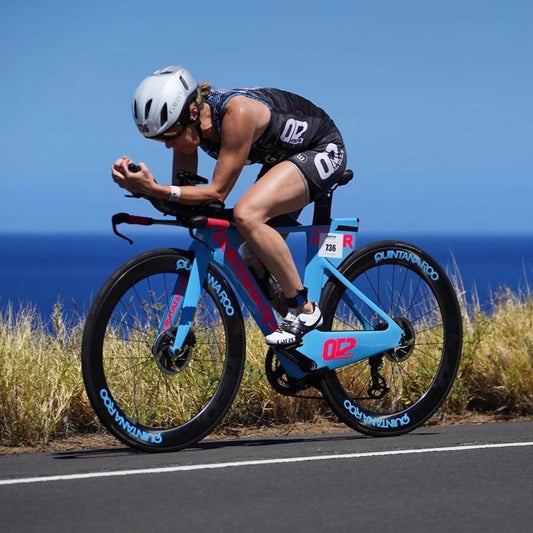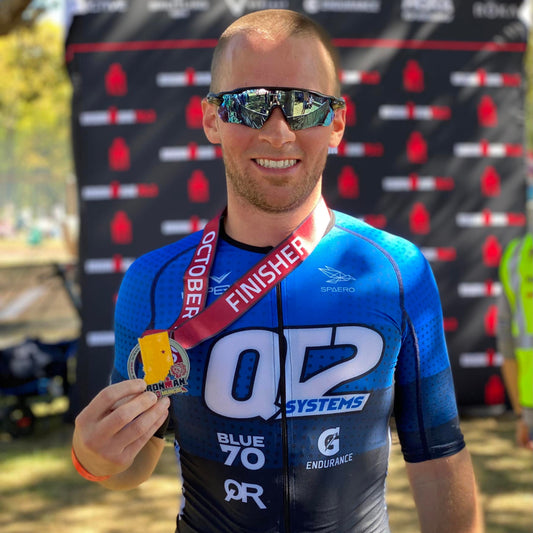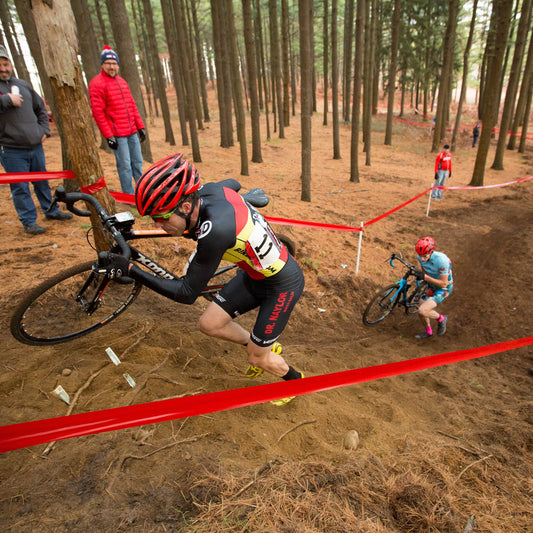
Let’s face it - injuries happen in triathlon. Incidence rates vary in the literature based on study design, athlete population, study length, definition of injury, and other characteristics, but have been reported to be anywhere from 37-87% of athletes (1). Ask around at the start of any race, and you’ll likely find the majority of athletes report having worked through some sort of “niggle” or pain. To further muddy matters, certain common pathologies may or may not be symptomatic in different individuals, or even in the same individual at different times. For example, one study of a general population in Japan found rotator cuff tendon tears in 36% of individuals with shoulder pain, but also in nearly 17% of asymptomatic individuals, with prevalence increasing with age (2). In another study, hip labral tears were identified in 69% of healthy participants with an average age of 37.8 (3). Knee meniscus tears are another common finding on MRI. One study found tears in 57% of symptomatic knees, but 63% of those patients also had tears in the opposite, asymptomatic knee (Zanetti). And none of this even gets into osteoarthritis, which can found somewhere, in some joint of almost any individual after a certain age.
So, in a sport where repetitive stress is inherent, and in a world where bodies might not be structurally “perfect” everywhere, how can we best balance these interests and maximize fitness while minimizing pain and damage? While “don’t train if something hurts” sounds good in theory, in practice, avoiding training unless zero pain is present is not realistic for many, and isn’t necessary for the majority of conditions. The desire to maintain or build fitness often needs to be balanced with the need to not overload compromised tissues or painful areas. The very premise of triathlon training is to progressively increase training load overall, while not exceeding the body’s ability for to recover and restore itself in order to produce positive adaptations to that training. Too much training load, and overtraining and breakdown occur; too little, and improvements are not made. In a way, working through niggles and pain is similar. Tendinopathies, in particular, need load to remodel and heal-a process that can take up to a year. The trick in this time is to ensure that loads sufficient to stimulate healing, but not so great that the body’s ability to heal is not compromised. This all sounds nice, but in the thick of training, when trying to evaluate how to deal with aches and pains without overstepping the limits, how does an athlete practically go about applying these principles? Thankfully, research and sense have given us some guidelines on how to proceed through those non-zero pain times!
No Suspicion of Bone Stress Injury
As stated above, the majority of injuries don’t require zero pain to be present in order to train. Bone stress injuries, though, are an exception. Bone stress injuries, which can range from reactions involving inflammation of the periosteum (the outer lining of the bone) and/or marrow edema (the bone’s “filling”) to full stress fractures (microcracks in the bone) occur when the stresses placed on a bone exceed its ability to remodel. This is a function of both the load placed on the bone from training (which includes impact forces and tensions), as well as the bone’s ability to withstand the load (which includes bone density and turnover). When a bone is beginning to show signs of a stress injury, further loading it will only worsen the injury, and full unloading is needed for healing. When symptoms raise suspicion for a bone stress injury, running in particular, and any other provocative activity that loads the bone and increases symptoms needs to be stopped. Symptoms that raise suspicion for bone stress injuries include pain that increases with activity and feels better at rest initially (in later stages, pain will persist, and may be worse at night), localized tenderness over a bone, and often pain with hopping or impact. Lower BMI females tend to be higher risk. Certain areas of the body are considered higher risk stress fractures, and prone to healing complications such as nonunion. These include the anterior tibia (shin bone), the femoral neck, and the navicular (a bone in the midfoot), so particular concern is warranted when pain occurs in the front of the shin, front of the hip or groin, and midfoot. When in doubt, hold on running and have these areas evaluated by a doctor!
Pain <5/10 (During and After Activity)
A clinical commentary by Silbernagel et al (5) proposed an evidence-based “pain monitoring model” to determine activity while rehabilitating Achilles tendinopathy, which serves as a useful guideline for many injuries and pains, especially tendinopathies. Under the model, pain levels of 0-2/10 are considered to be in the “safe zone” for continuing activity, while levels of 3-5/10 or less are considered to be “acceptable”. This includes during activity, immediately afterwards, and the following morning. Sounds nice in theory, but subjective pain ratings are imperfect and can be difficult for many, especially in a sport where learning to “get uncomfortable being uncomfortable” and embrace pain has competitive benefits. For those that might struggle to assign a number to pain, in general, pain that is perceived as low-level and stable on both a shorter (day-to-day) and longer (weeks to months) term basis is considered to be reasonable for continuing training.
Pain Does Not Increase Over Time
That whole “stable on a longer-term basis” idea brings us to the next point on the list. Part of the pain monitoring model includes pain and stiffness that do not increase on a week-to-week basis. So, when attempting to work through an issue, part of an athlete’s program should include an honest assessment each week as to whether or not pain has increased from the previous week. This can be difficult to judge, though, since slight increases on a weekly basis might not be obvious, but add over time, and constantly concentrating on exact pain level can be mentally exhausting (and counterproductive). An athlete also might accept some extra pain in the last week of a build or when nearing a race, figuring that a recovery week would be sufficient for a reset, but perhaps not return to baseline in that recovery time-repeat this over time, and it adds up. So, while the model might only mention weeks, progression over months, seasons, years might be more obvious. I’m occupying myself with blogs at the moment because I recently underwent surgery to repair some chronic high hamstring issues. While I never perceived my pain with training to be greater than a 5/10, and I was unable to detect small nuances on a weekly basis, over the course of the past several years, it became clear that my baseline pain had shifted up significantly, and I was no longer able to reset after training blocks and races, or really even enjoy training that much anymore and perform well (more on that later). And while I generally could train through the left-sided pain, I ended up suffering from some “hard stop” injuries in the other leg due to compensations, which leads to the next item...
Pain Does Not Change Mechanics
Years ago, I decided to run barefoot on sand, gave myself massive blisters, insisted upon running the next day, compensated for the blisters by shifting my landing pattern onto the outside of my foot, and ended up angering a tendon and taking myself out for a month. This is a pretty short term, acute example, but pain that causes some sort of shift in run gait pattern, cycling balance, or swim stroke will, eventually, load another structure potentially beyond its ability to withstand that load. Going back to that hamstring, the subtle gait hitch I developed over time compensating for the daily left-sided pain and stiffness eventually contributed to the development of a right-sided hip stress fracture on training loads that, in the past, were well below my threshold for issues. So, if the mechanics are off, stick with activities that are able to be completed without compensation until symptoms and imbalances are addressed and corrected! One note here-this doesn’t apply if a biomechanical change is intentionally made in order to address faulty mechanics that might have contributed to the development of the injury, which will be elaborated on in later blogs.
Consideration - Time of Season
This is a nuanced one in the complicated “can/should I train through this?” algorithm. Take, for example, an athlete who might have some on and off hip pain flare up a bit, but never at greater than that 5/10 level, who’s eyeing a late summer “A” race. Some hip pain that presents while in the early stages of training in January should be dealt with differently than a flare in the height of summer training. When performance on a shorter or intermediate-term basis is not priority, decreasing training more aggressively in order get niggles (especially new ones) fully controlled prior to attempting to really increase training loads is indicated. On the other hand, dealing with some degree of low-level pain when working through peak training in order to optimize performance for a goal race can be accepted. So, as much as any involuntary time off is never desired, where in a training cycle an athlete is becomes an important consideration in the “should I train through it?” question. How important to the athlete’s upcoming race goals is the current training? When inside of the final 10-12 weeks, when the training is more crucial and recovery post-race is possible in the short or intermediate term future, using the guidelines and interventions to continue to train through some pain might be necessary. Otherwise, a few weeks in time to nip issues in the bud is typically the better decision.
Pain Does Not Outweigh Positives From Training, or Interfere With Quality of Life
This criteria isn’t exactly clear-cut either, but falls into the category of, “you’ll know it when you get there”. We all have our different reasons for training and competing, but the bottom line is that we chose to do so because it adds some benefit to our lives-health, enjoyment, stress relief, satisfaction, empowerment. What happens, though, when some “bad” pain gets thrown into the training equation? At low enough levels, it might still be possible to enjoy the activity, relieve stress, perform well, etc. At higher levels, though, training and racing starts to cease to be enjoyable. Instead of relieving stress, pain just becomes another source of it. The satisfaction that comes from finishing a workout starts to get outweighed by the pain that follows, even if good performance is still possible. For those that might struggle to assign a numerical value to pain, an honest assessment of the net positives of training vs negatives of pain might be better. This applies to day-to-day activities, too. Maybe an athlete can still hit a workout, but it then comes at the expense of pervasive pain with the rest of normal daily activities. When pain starts to become distracting throughout the rest of the day, it’s likely time to take a step back, and really think about what’s happening. Is a run really worth a nagging ache throughout the rest of the day, that interferes with the enjoyment of other activities? Probably not. Athletes tend to frame injury in terms of whether or not it prevents training or racing, but pain, at its basic level, is a negative feeling and emotion that can interfere with quality of life, and admitting this takes honesty and strength.
So, for the majority of athletes, dealing with niggles, chronic injuries, and pain somewhere along the line is a part of training for triathlon. The decision on whether to train or rest in the face of bodies not feeling perfect is rarely black and white (unless bone is involved, in which case, the “stop” message is clear. Athletes need to be honest with themselves and their coaches (I’ll be the first to admit that this hasn’t always been my own personal forte in life), and consider aspects such as pain level, progression over time, season goals and stage, and overall quality of life. The guidelines above give some insight as to some criteria that can be used to judge the million dollar “can I train through it?” question, and in the next blog, we’ll get a bit more into some steps that can be taken to modify training and address pain when it strikes!
References:
(1) Kienstra, Carolyn M. MD1; Asken, Tristen R. PT, DPT, CSCS2; Garcia, Jennifer D. PT, DPT, MTC2; Lara, Vanessa MS, ATC, LAT3; Best, Thomas M. MD, PhD4. Triathlon Injuries: Transitioning from Prevalence to Prediction and Prevention. Current Sports Medicine Reports. 2017; 16(6):397-403. doi: 10.1249/JSR.0000000000000417
(2) Atsushi Yamamoto, Kenji Takagishi, Toshihisa Osawa, Takashi Yanagawa, Daisuke Nakajima, Hitoshi Shitara, Tsutomu Kobayashi. Prevalence and risk factors of a rotator cuff tear in the general population. Journal of Shoulder and Elbow Surgery. 2019; 19(1) 2010: 116-120. https://doi.org/10.1016/j.jse.2009.04.006.
(3) Register B, Pennock AT, Ho CP, Strickland CD, Lawand A, Philippon MJ. Prevalence of Abnormal Hip Findings in Asymptomatic Participants: A Prospective, Blinded Study. The American Journal of Sports Medicine. 2012;40(12):2720-2724. doi:10.1177/0363546512462124
(4) Marco Zanetti1, Christian W. A. Pfirrmann1, Marius R. Schmid1, José Romero2, Burkhardt Seifert3 and Juerg Hodler. Patients with Suspected Meniscal Tears: Prevalence of Abnormalities Seen on MRI of 100 Symptomatic and 100 Contralateral Asymptomatic Knees. American Journal of Roentgenology. 2003;181: 635-641. 10.2214/ajr.181.3.1810635.
(5) Silbernagel KG, Crossley KM. A Proposed Return-to-Sport Program for Patients With Midportion Achilles Tendinopathy: Rationale and Implementation. J Orthop Sports Phys Ther. 2015 Nov;45(11):876-86. doi: 10.2519/jospt.2015.5885. Epub 2015 Sep 21. PMID: 26390272.
This post was written by QT2 Level 1 Coach, Jennie Hansen.





